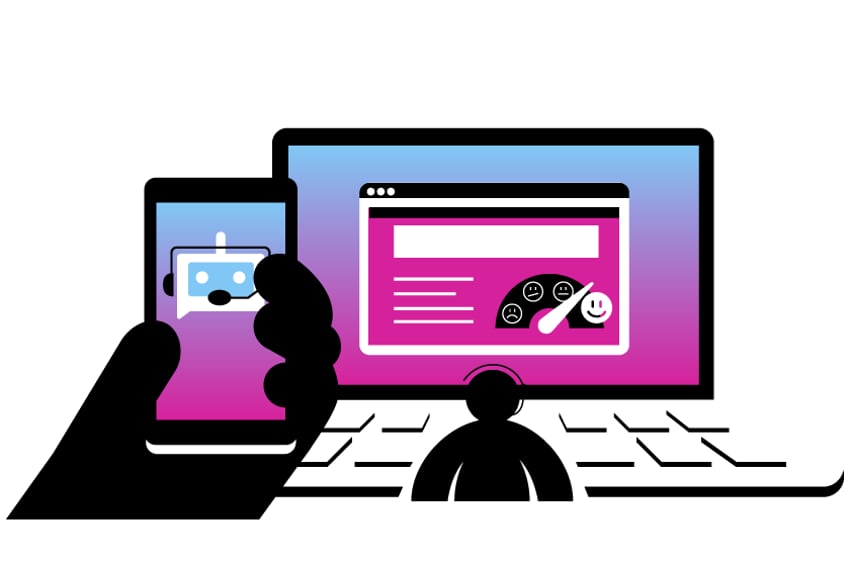Using WebSockets to Enhance CX
Have you heard about WebSockets? If not, perhaps you should. Many industry pundits are calling it a game changer for client/server web technology. WebSockets represent a standard for bi-directional real-time communication between servers and clients.

WebSockets Defined
WebSockets is a computer communications protocol that enables persistent, two-way communication over a single TCP connection without the overhead of the HTTP request/response model. WebSockets is a universal connector that fits any Artificial Intelligence (AI) engine you want to connect and makes real-time communication much more efficient — saving bandwidth, CPU power, latency — and is virtually no more complex than HTTP for developers to implement.
As a developer focused on delivering an exceptional customer experience (CX), you can use WebSockets to more effectively:
Direct more customer inquiries to self-service tools to promote faster resolutions: Leverage your organization’s knowledge base to enable chatbots to promote customer satisfaction with rapid responses to simple inquiries, while enabling more complex inquiries to be managed by human interaction. Continued bot self-learning will also lead to expanded self-service and further optimize your support experience.
Provide your contact center agents and managers with a real-time representation of the customer’s experience: The best possible experience starts with an immediate understanding of your customer. This can be particularly challenging in a noisy contact center where even the highest level of call quality can be drowned out by the cacophony of agents speaking over one another struggling to be heard by their respective customers.
Augment your support processes with AI: Creating an engaging and satisfying customer experience can be a real challenge for even the most technologically sophisticated contact center or brand. Accenture, for instance, has estimated that the introduction of AI will increase business productivity by up to 80% by 2035. Customer service is one of the business functions expected to benefit most from AI.
WebSockets leverages your AI engines to more effectively energize your organization’s voice experience and enhance CX for your clients.
WebSockets Helps Put Customers First
Your customers can achieve more immediate resolutions to their simple requests with WebSockets connected to your AI endpoints, helping to ensure that more complex needs are quickly prioritized and redirected. AI benefits such as Natural Language Understanding and Natural Language Processing are realized in real-time.
For example, when utilizing virtual agents — bots that address simple FAQs — and routing the more complex questions to skilled human agents, WebSockets promotes a better experience for customers while enabling greater efficiencies within a contact center. Continuous WebSockets connections enhance CX in this use case by enabling real-time interactions and handoffs.

Performing sentiment analysis in call centers to determine customer satisfaction is another example of analyzing calls using third-party solutions that are enhanced by WebSockets. The Vonage Voice API can conference in an AI bot, such as IBM Watson, Amazon Alexa, or others, to participate in a call. Adding in sentiment analysis provides agents and managers with a real-time visual representation of the customer’s experience, indicating how happy or unhappy they are at any given point of the conversation. With this information, agents can more readily recognize when things have taken a negative turn and adjust course, or when things are going well and continue on their current path to support the customer.
Similar to sentiment analysis, real-time transcription is enhanced by WebSockets using the same third party AI engines. At any given time an agent is expected to find the answer to a customer’s question, keep the customer engaged and happy, input data into whatever system they might be using and, of course, keep track of what was said during the course of the conversation. Using real-time transcription overcomes this challenge, allowing businesses to capture the entirety of the conversation and take action on it. For example, searching for keywords or terms; with this information in hand, brands can hone in on what worked and what did not with regard to an agent’s messaging. The findings can then be folded into training modules ensuring that new agents (and existing ones participating in ongoing training) benefit from this ever expanding knowledge base.

Considerations When Selecting a WebSockets Vendor
When selecting a vendor to deploy WebSockets to enhance your CX, you should consider the following factors:
Scalability: Not only should your WebSockets fit any AI system you want to connect, you should also have the ability to deploy a virtually unlimited number of AI connections available per call. An optimum solution that provides a more complete experience can be both easy and straightforward for building voice bots, as well as available for background media analysis.
Flexibility: You should be able to choose from AI partners within your vendor’s network or have the ability to select a third party vendor that best fits your unique customer experience use case and business goals.
Easy to Deploy: Choose a vendor that offers binary media message format for WebSockets. This requires less coding than solutions that utilize base64-encoded in JSON.
We hope this helps you feel a little more like a WebSockets expert. You can always learn more about how using Websockets can enhance CX and deliver exceptional experiences.